Cardiac Science AED G3 Pro Service manual
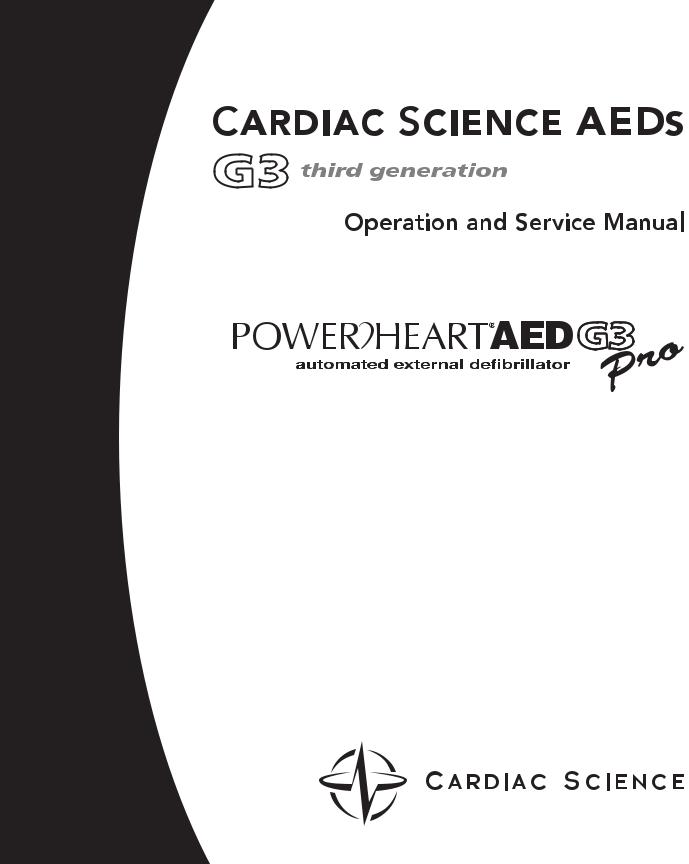

Limited Warranty for Powerheart AED G3 Pro
Limited Warranty
Cardiac Science Corp. (“Cardiac Science”) warrants to the original purchaser that its AEDs and stated battery will be free of any defect in material and workmanship according to the terms and conditions of this Limited Warranty (“Limited Warranty”). For purposes of this Limited Warranty, the original purchaser is deemed to be the original end user of the product purchased. This Limited Warranty is NONTRANSFERABLE and UNASSIGNABLE.
For How Long?
Seven (7) years from the date of the original shipment to the original purchaser for Powerheart AED G3 Pro automated external defibrillators. Disposable defibrillation pads shall be warranted until the expiration date. Lithium batteries (P/N 9145) have a full operational replacement warranty of one (1) year from the date of installation into a Powerheart AED G3 Pro (P/N 9300P-001/201) or 12 hours of use, whichever occurs first. One (1) year from the date of original shipment to the original purchaser for Cardiac Science AED accessories. The terms of the Limited Warranty in effect as of the date of original purchase will apply to any warranty claims.
What You Must Do
Please complete and submit the Warranty Validation Form within 30 days of original shipment located at http://www.cardiacscience.com/ products/aed_warranty.cfm. If the purchaser does not have internet access, call (888) 466-8686.
To obtain warranty service for your product, call us toll free at (888) 466-8686 seven days a week, 24 hours a day. Our customer service representative will try to resolve your issue over the phone. If necessary, and at our sole discretion, we will arrange for service or a replacement of our product.
What We Will Do
If your Cardiac Science product is returned within 30 days of the date it was purchased, at the direction of a customer service representative, we will replace it with a new product of equal value at no charge to you, provided the warranty applies.
If your Cardiac Science product is returned, at the direction of a customer service representative, after 30 days but within the warranty period, Cardiac Science, at its sole discretion, will repair your product or replace it. The repaired or replacement product will be warranted subject to the terms and conditions of this Limited Warranty for either (a) 90 days or
(b) the remainder of the original warranty period, whichever is longer, provided the warranty applies and the warranty period has not expired.
Obligations and Warranty Limits
Limited Warranty Obligation: Exclusive Remedy
THE FOREGOING LIMITED WARRANTY IS IN LIEU OF AND SPECIFICALLY EXCLUDES AND REPLACES ALL OTHER EXPRESSED OR IMPLIED WARRANTIES. INCLUDING BUT NOT LIMITED TO THE IMPLIED WARRANTIES OF MERCHANTABILITY AND FITNESS FOR A PARTICULAR PURPOSE.
Some states do not allow limitations on how long an implied warranty lasts, so this limitation may not apply to you.
NO PERSON (INCLUDING ANY AGENT, DEALER, OR REPRESENTATIVE OF CARDIAC SCIENCE) IS AUTHORIZED TO MAKE ANY REPRESENTATION OR WARRANTY CONCERNING CARDIAC SCIENCE PRODUCTS, EXCEPT TO REFER PURCHASERS TO THIS LIMITED WARRANTY.
YOUR EXCLUSIVE REMEDY WITH RESPECT TO ANY AND ALL LOSSES OR DAMAGES RESULTING FROM ANY CAUSE WHATSOEVER SHALL BE AS SPECIFIED ABOVE. CARDIAC SCIENCE SHALL IN NO EVENT BE LIABLE FOR ANY CONSEQUENTIAL OR INCIDENTAL DAMAGES OF ANY KIND, INCLUDING, BUT NOT LIMITED TO, EXEMPLARY DAMAGES, COMMERCIAL LOSS FROM ANY CAUSE, BUSINESS INTERRUPTION OF ANY NATURE, LOSS OF PROFITS OR PERSONAL INJURY, EVEN IF CARDIAC SCIENCE HAS BEEN ADVISED OF THE POSSIBILITIES OF SUCH DAMAGES, HOWEVER OCCASIONED, WHETHER BY NEGLIGENCE OR OTHERWISE.
Some states do not allow the exclusion or limitation of incidental or consequential damages, so the above limitation or exclusion may not apply to you.
What This Warranty Does Not Cover
This Limited Warranty does not cover defects or damages of any sort resulting from, but not limited to, accidents, damage while in transit to our service location, alterations, unauthorized service, unauthorized product case opening, failure to follow instructions, improper use, abuse, neglect, fire, flood, war or acts of God. Cardiac Science makes no warranty claim as to the compatibility with Cardiac Science products with non Cardiac Science products.
This Limited Warranty is Void if…
•Any Cardiac Science product is serviced or repaired by any person or entity other than Cardiac Science unless specifically authorized by Cardiac Science.
•Any Cardiac Science product case is opened by unauthorized personnel or if a product is used for an unauthorized purpose.
•Any Cardiac Science product is used in conjunction with incompatible parts or accessories, including but not limited to batteries. Parts and accessories are not compatible if they are not Cardiac Science products or the functional equivalent.
If The Warranty Period has Expired…
If your Cardiac Science product is not covered by our Limited Warranty, call us toll free at (888) 466-8686 for advice as to whether we can repair your Cardiac Science product, and for other repair information, including charges. Charges for non-warranty repairs will be assessed and are your responsibility. Upon completion of the repair, the terms and conditions of this Limited Warranty shall apply to such repair or replacement product for a period of 90 days.
This warranty gives you specific legal rights, and you may also have other rights, which vary from state to state.
© 2006 Cardiac Science Corp. All rights reserved. |
page 1 |

page 2 |
112-2034-301 Rev B |
© 2006 Cardiac Science Corp. All rights reserved. |

Cardiac Science AED G3 Pro Operation and Service Manual
CAUTION
Federal law restricts this device to be sold by or on the order of a physician or practitioner licensed by state law in which he/she practices to use or order the use of the device.
IMPORTANT
Read this Operation and Service Manual carefully. It contains information about your safety and the safety of others. Become familiar with the controls and how to use the AED properly before operating the product.
Cardiac Science AEDs are manufactured by:
Corporate Headquarters:
Cardiac Science Corporation
Bothell, WA 98021 U.S.A.
Web site: www.cardiacscience.com
E-mail: info@cardiacscience.com
Manufacturing:
Cardiac Science Corporation
Deerfield, WI 53531 U.S.A.
Authorized European Representative:
MDSS
Burckhardtstrasse 1
D-30163 Hannover
Germany
TRADEMARK INFORMATION
FirstSave, Powerheart, MasterTrak, MDLink, STAR, IntelliSense, RescueReady, RescueLink, RHYTHMx and Survivalink are trademarks and registered trademarks of Cardiac Science Corp. Microsoft and Windows are registered trademarks of Microsoft Corporation. All other trademarks are the property of their respective owners.
PATENTS
This device may be covered by the following U.S. and foreign patents:
5,792,190, 5,999,493, 5,402,884, 5,579,919, 5,749,902, 5,645,571, 6,029,085, 5,984,102, 5,919,212, 5,891,172, 5,674,266, 5,700,281, 5,891,173, 5,968,080, 6,263,239, 5,797,969, D402,758, D405,754, 5,909,138, 6,173,203, 6,088,616, 5,897,576, 5,955,956, 6,083,246, 6,064,909, 6,038,473, 5,868,794, 6,115,638, 6,366,809, 5,474,574, 6,246,907, 6,289,243, 6,411,846, 6,480,734, EP00756878
Other U.S. and foreign patents pending.
© 2006 Cardiac Science Corp. All rights reserved. |
112-2034-301 Rev A |
page 3 |

LIMITED WARRANTY
The Cardiac Science AED Operation and Service Manual and any and all information contained herein do not constitute any warranty as to the Powerheart AED G3 Pro, or any related products in any manner whatsoever. The “Limited Warranty” is shipped with the AED and serves as the sole and exclusive warranty provided by Cardiac Science regarding Cardiac Science AED products.
ORDER ENTRY
To order additional Cardiac Science AEDs or accessories:
Worldwide
Toll Free: 800.991.5465
Telephone: 425.402.2000
Fax: 425.402.2001
Email: aedorders@cardiacscience.com
CUSTOMER SERVICE
To receive 24-hour customer support: |
|
US/INTERNATIONAL |
Email: customerservice@cardiacscience.com |
CUSTOMER SERVICE/TECHNICAL SUPPORT |
internationalsales@cardiacscience.com |
Toll Free: +1.888.466.8686 / 425-402-2691 |
techsupport@cardiacscience.com |
+1.800.991.5465 / 425-402-2690 |
internationalservice@cardiacscience.com |
There is no charge to the customer for a customer support call. Please have the serial and model numbers available when contacting Customer Service. (The serial and model numbers are located on the underside of the Cardiac Science AED.)
NOTICE OF RIGHTS
All rights reserved. No part of this documentation may be reproduced or transmitted in any form by any means without the express written permission of Cardiac Science Corp. Information in this documentation is subject to change without notice. Names and data used in the examples are fictitious unless otherwise noted.
DEFIBRILLATOR TRACKING
Defibrillator manufacturers and distributors are required, under the Safe Medical Devices Act of 1990, to track the location of defibrillators they sell. Please notify Cardiac Science Customer Service in the event that your defibrillator is sold, donated, lost, stolen, exported, destroyed or if it was not purchased directly from Cardiac Science Corp.
page 4 |
112-2034-301 Rev B |
© 2006 Cardiac Science Corp. All rights reserved. |

Cardiac Science AED G3 Pro Operation and Service Manual
TABLE OF CONTENTS |
|
SECTION 1 - SAFETY |
|
OVERVIEW........................................................................................................................................................ |
7 |
SAFETY TERMS DEFINITIONS .......................................................................................................................... |
7 |
SAFETY ALERT DESCRIPTIONS ....................................................................................................................... |
8 |
SYMBOL DESCRIPTIONS ............................................................................................................................... |
11 |
SECTION 2 - INTRODUCTION |
|
OVERVIEW...................................................................................................................................................... |
15 |
AED DESCRIPTION ......................................................................................................................................... |
15 |
INDICATIONS FOR USE .................................................................................................................................. |
15 |
RHYTHMx AED ECG ANALYSIS ALGORITHM................................................................................................. |
16 |
RESCUE PROTOCOL....................................................................................................................................... |
18 |
STAR BIPHASIC WAVEFORM.......................................................................................................................... |
18 |
STAR BIPHASIC ENERGY PROTOCOLS FOR POWERHEART AED G3 PRO .................................................... |
18 |
OPERATOR TRAINING REQUIREMENTS ........................................................................................................ |
20 |
SECTION 3 - GETTING STARTED |
|
OVERVIEW...................................................................................................................................................... |
21 |
UNPACKING AND INSPECTING ...................................................................................................................... |
21 |
AED PARTS..................................................................................................................................................... |
22 |
AED MODES.................................................................................................................................................... |
23 |
POWERHEART AED G3 PRO BATTERIES ....................................................................................................... |
24 |
RECHARGEABLE BATTERY AND CHARGER ................................................................................................... |
26 |
DEFIBRILLATION PADS (ELECTRODES)......................................................................................................... |
28 |
AED INDICATORS ........................................................................................................................................... |
29 |
SETTING THE AED INTERNAL CLOCK ............................................................................................................ |
33 |
VOICE PROMPTS AND TEXT DISPLAY........................................................................................................... |
33 |
SECTION 4 - INSTRUCTIONS FOR USE |
|
OVERVIEW...................................................................................................................................................... |
37 |
OPERATING MODES ....................................................................................................................................... |
37 |
STEP 1: ASSESSMENT AND PAD PLACEMENT.............................................................................................. |
38 |
STEP 2: ECG ANALYSIS (AED MODE) ............................................................................................................ |
39 |
STEP 3: SHOCK DELIVERY AND CPR MODE (AED MODE) ............................................................................ |
40 |
STEP 4: POST RESCUE................................................................................................................................... |
40 |
© 2006 Cardiac Science Corp. All rights reserved. |
112-2034-301 Rev A |
page 5 |

SECTION 4 - INSTRUCTIONS FOR USE (CONT’D) |
|
USING MANUAL OVERRIDE (MANUAL MODE) .............................................................................................. |
41 |
ECG DISPLAY FOR ONGOING MONITORING (ECG MONITORING MODE)...................................................... |
42 |
Z-BAR INDICATOR .......................................................................................................................................... |
43 |
WARNINGS..................................................................................................................................................... |
44 |
SECTION 5 - DATA MANAGEMENT |
|
OVERVIEW...................................................................................................................................................... |
45 |
RECORDING RESCUE DATA............................................................................................................................ |
45 |
REVIEWING RESCUE DATA ............................................................................................................................ |
45 |
MULTIPLE RESCUE FUNCTIONALITY ............................................................................................................. |
46 |
SECTION 6 - MAINTENANCE & TROUBLESHOOTING |
|
OVERVIEW...................................................................................................................................................... |
47 |
SELF-TESTS.................................................................................................................................................... |
47 |
INDICATOR TROUBLESHOOTING TABLE........................................................................................................ |
48 |
SCHEDULED MAINTENANCE .......................................................................................................................... |
49 |
AUTHORIZED REPAIR SERVICE ..................................................................................................................... |
50 |
FREQUENTLY ASKED QUESTIONS ................................................................................................................. |
51 |
SECTION 7 - TECHNICAL DATA |
|
OVERVIEW...................................................................................................................................................... |
53 |
PARAMETERS................................................................................................................................................. |
53 |
SAFETY AND PERFORMANCE STANDARDS................................................................................................... |
56 |
STAR BIPHASIC WAVEFORM.......................................................................................................................... |
59 |
RHYTHMx ECG ANALYSIS PERFORMANCE ................................................................................................... |
61 |
SECTION 8 - MDLINK |
|
OVERVIEW...................................................................................................................................................... |
63 |
MDLINK INSTALLATION ................................................................................................................................. |
64 |
ESTABLISH CONNECTION FROM THE AED TO THE COMPUTER ................................................................... |
65 |
SELECTABLE OPTIONS PARAMETERS ........................................................................................................... |
68 |
COMMAND BUTTONS .................................................................................................................................... |
71 |
page 6 |
112-2034-301 Rev B |
© 2006 Cardiac Science Corp. All rights reserved. |
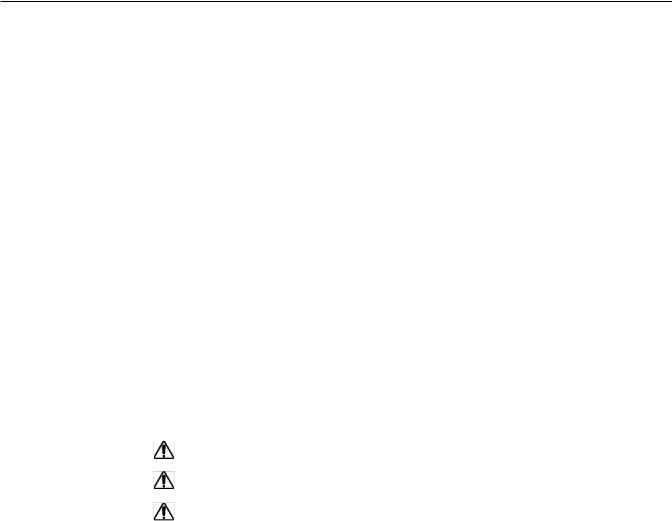
Section 1 - Safety
SECTION 1 – SAFETY
OVERVIEW
This section presents safety information to guard against injury to persons and damage to the Powerheart AED G3 Pro.
TOPIC |
PAGE # |
Safety Terms Definitions |
7 |
Safety Alert Descriptions |
8 |
Symbol Descriptions |
11 |
SAFETY TERMS DEFINITIONS
BEFORE OPERATING THE POWERHEART AED G3 PRO
Become familiar with the various safety alerts in this section.
Safety alerts identify potential hazards using symbols and words to explain what could potentially harm you, the patient, or the Powerheart AED G3 Pro.
SAFETY TERMS AND DEFINITIONS
The triangle attention symbol shown below, left, identifies the potential hazard categories. The definition of each category is as follows:
DANGER: This alert identifies hazards that will cause serious personal injury or death.
WARNING: This alert identifies hazards that may cause serious personal injury or death.
CAUTION: This alert identifies hazards that may cause minor personal injury, product damage, or property damage.
PRODUCT REFERENCES
For purposes of retaining simple, clear instructions in this manual, note the product references used. Features, specifications, operating instructions and maintenance on the Powerheart AED G3 Pro will be referred to as “AED” or “device”.
Defibrillation electrodes will be referred to as “defibrillation pads” or “pads”, ECG monitoring electrodes will be referred to as “ECG monitoring electrodes” or “ECG electrodes”.
Features and specifications vary, so please read this manual carefully. For questions regarding the differing features among Cardiac Science AEDs, please contact Customer Service (see page 4).
© 2006 Cardiac Science Corp. All rights reserved. |
112-2034-301 Rev A |
page 7 |
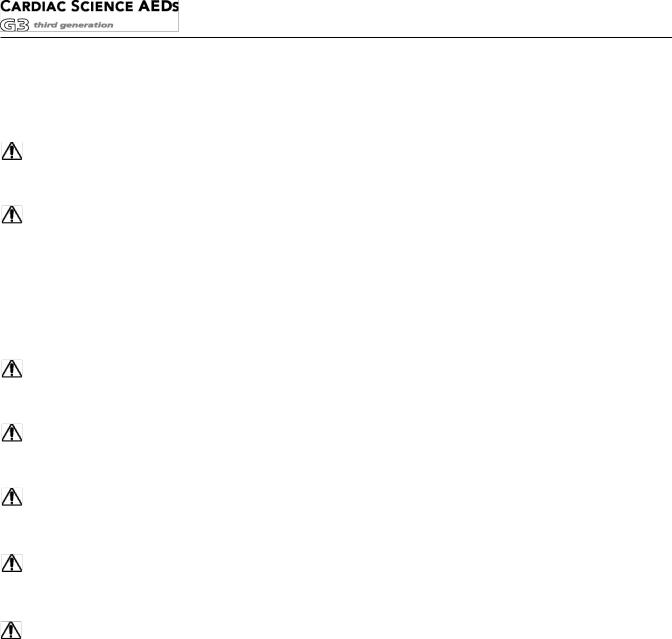
SAFETY ALERT DESCRIPTIONS
The following is a list of Cardiac Science AED safety alerts that appear in this section and throughout this manual. You must read, understand, and heed these safety alerts before attempting to operate the AED.
DANGER: Fire and Explosion Hazard
Exercise caution when operating the AED close to flammable gases (including concentrated oxygen) to avoid possible explosion or fire hazard.
WARNING: Shock Hazard
Defibrillation shock current flowing through unwanted pathways is potentially a serious electrical shock hazard. To avoid this hazard during defibrillation abide by all of the following:
•Do not touch the patient, unless performance of CPR is indicated
•Do not touch metal objects in contact with the patient
•Keep defibrillation pads and ECG electrodes clear of other electrodes or metal parts in contact with patient
•Disconnect all non-defibrillator proof equipment from the patient before defibrillation
WARNING: Shock and Possible Equipment Damage
Disconnect all non-defibrillator proof equipment from the patient before defibrillation to prevent electrical shock and potential damage to the equipment.
WARNING: Battery (P/N: 9145) is NOT Rechargeable
Do not attempt to recharge the battery. Any attempt to recharge the battery may result in an explosion or fire hazard. Only battery (P/N: 9144) is rechargeable.
WARNING: Shock Hazard
Do not disassemble the AED! Failure to observe this warning can result in personal injury or death. Refer maintenance issues to Cardiac Science authorized service personnel.
WARNING: Battery Serviceability
Do not disassemble the battery! Failure to observe this warning can result in personal injury or death. Refer maintenance issues to authorized service personnel.
CAUTION: Temperature Extremes
Exposing the AED to extreme environmental conditions outside of its operating parameters may compromise the ability of the AED to function properly. The RescueReady® daily self-test verifies the impact of extreme environmental conditions on the AED; if the daily self-test determines environmental conditions outside of the AED’s operating parameters, a “SERVICE REQUIRED” alert will be issued to prompt the user to move the AED to environmental conditions within the acceptable operating parameters at once. See Section 7 – Technical Data, Parameters, Operation and Standby Conditions.
page 8 |
112-2034-301 Rev B |
© 2006 Cardiac Science Corp. All rights reserved. |
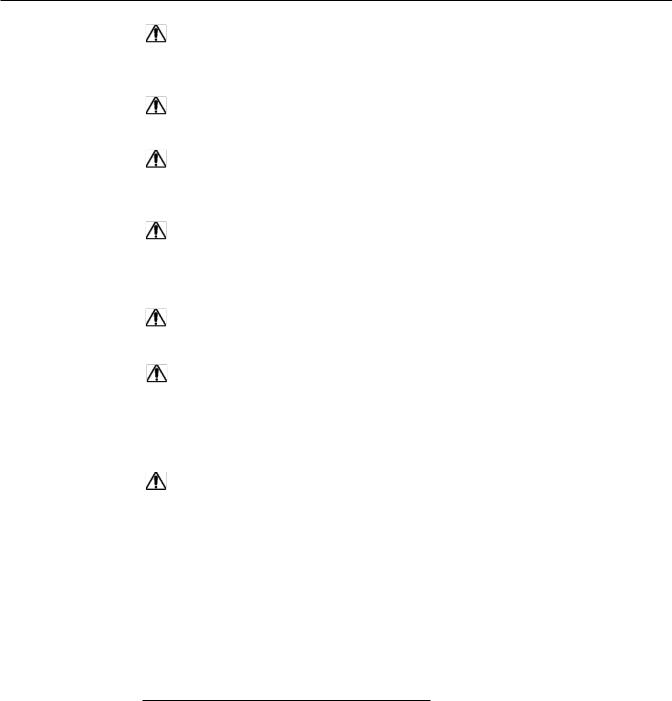
Section 1 - Safety
CAUTION: Lithium Sulfur Dioxide Battery
Pressurized contents: Never recharge, short circuit, puncture, deform, or expose to temperatures above 65°C (149°F). Remove the battery when discharged.
CAUTION: Lithium-ion Battery
Never short circuit, puncture, deform, or expose to temperatures above 65°C (149°F).
CAUTION: Battery Disposal
Recycle or dispose of the lithium battery in accordance with all federal, state and local laws. To avoid fire and explosion hazard, do not burn or incinerate the battery.
CAUTION: Use only Approved Equipment
The Rechargeable battery is made solely for Powerheart AED G3 Pro, and is NOT to be used with any other AED models. Using batteries, pads, cables, or optional equipment other than those approved by the manufacturer may cause the AED to function improperly during a rescue.
CAUTION: Possible Improper AED Performance
Using defibrillation pads that are damaged or expired may result in improper AED performance.
CAUTION: Possible Radio Frequency (RF) Susceptibility
RF susceptibility from cellular phones, CB radios and FM 2-way radio may cause incorrect rhythm recognition and subsequent shock advisory. When attempting a rescue using the AED, do not operate wireless radiotelephones within 2 meters of the AED – turn power OFF to the radiotelephone and other like equipment near the incident.
CAUTION: Possible Interference with Implanted Pacemaker
Therapy should not be delayed for patients with implanted pacemakers and a defibrillation attempt should be made if the patient is unconscious and not breathing. The AED has pacemaker detection and rejection, however with some pacemakers the AED may not advise a defibrillation shock.1
Placing Defibrillation Pads:
•Do not place the defibrillation pads directly over an implanted device.
•Place the defibrillation pads at least one inch from any implanted device.
1 Cummins, R., ed., Advanced Cardiac Life Support; AHA (1994): Ch. 4.
© 2006 Cardiac Science Corp. All rights reserved. |
112-2034-301 Rev A |
page 9 |

CAUTION: Moving the Patient During a Rescue
During a rescue attempt, excessive jostling or moving of the patient may cause AEDs to improperly analyze the patient’s cardiac rhythm. Stop all motion or vibration before attempting a rescue.
CAUTION: Case Cleaning Solutions
When disinfecting the case, use a non-oxidizing disinfectant, such as ammonium salts or a glutaraldehyde based cleaning solution, to avoid damage to the metal connectors.
CAUTION: The AED is programmed with software that has been tested to work with versions of Rescuelink and MDLink that are included with the AED. When using older version of Rescuelink and MDLink are used to communicate with this AED, there may be features described in this manual that are not available to be used. Also, when communicating with an older AED with the version of Rescuelink and MDLink included with this new AED there may be features described in this manual that cannot be edited. The software in most cases will give an error message when incompatibilities occur.
page 10 |
112-2034-301 Rev B |
© 2006 Cardiac Science Corp. All rights reserved. |
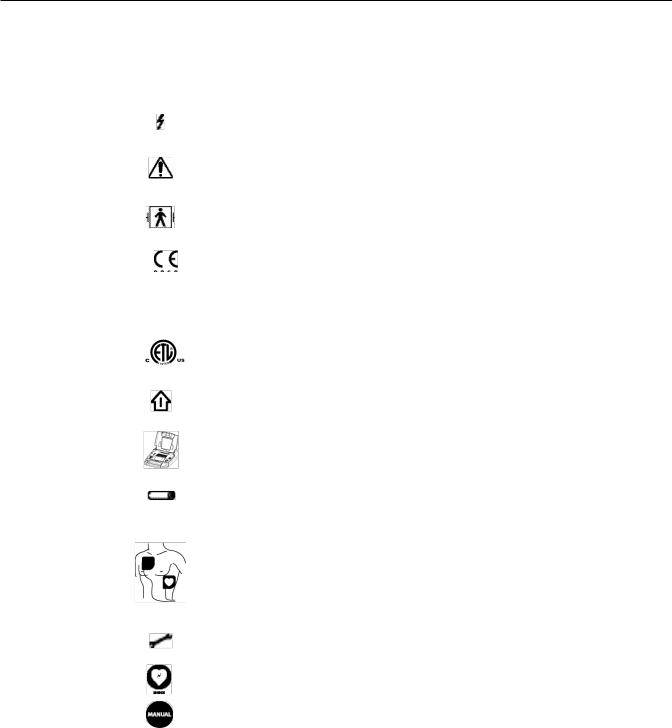
Section 1 - Safety
SYMBOL DESCRIPTIONS
The following symbols may appear in this manual, on the AED, or on its optional components. Some of the symbols represent standards and compliances associated with the AED and its use.
0 0 8 6
IP24
Dangerous Voltage: The defibrillator output has high voltage and can present a shock hazard. Please read and understand all safety alerts in this manual before attempting to operate the AED.
Attention!: Identifies important information in this manual, on the AED, or on its component parts regarding the safe and proper use of the AED.
Defibrillator Proof Type BF Equipment: The AED, when connected to the patient’s chest by the defibrillation pads, can withstand the effects of an externally applied defibrillation shock.
CE Mark: This equipment conforms to essential requirements of the Medical Device Directive 93/42/EEC.
The AED is protected against the effects of splashing water in accordance with IEC 60529.
Classified by ETL Semko with respect to electric shock, fire and mechanical hazards only in accordance with UL 60601-1, CAN/CSA C22.2 No.601.1-M90, EN60601-1 and EN60601-2-4. Conforms to UL Standard UL60601-1. Certified to CAN/CSA Standard C22.2 No. 601.1-M90.
International symbol for ON. Open the lid to turn on the AED.
Open the lid to turn ON the AED.
Indicates the AED battery status. The illuminated areas indicate the remaining battery capacity.
1.Position of defibrillation pads on the chest of patient.
2.When pads on screen are flashing, check defibrillation pads. The defibrillation pads are missing, not connected or have compromised functionality.
Indicates AED requires maintenance by authorized service personnel.
When the SHOCK indicator is lit, push this button to deliver a defibrillation shock. When pushed and confirmed, activates manual mode.
© 2005 Cardiac Science Corp. All rights reserved. |
112-2034-301 Rev A |
page 11 |
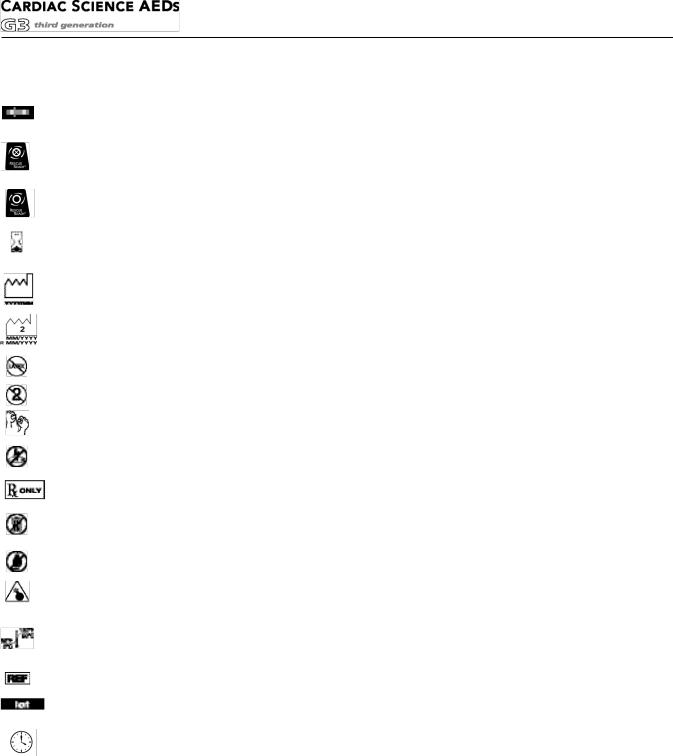
SYMBOL DESCRIPTIONS (CONT.)
The Z-Bar provides a relative visual indicator of the total transthoracic impedance between the two defibrillation pads.
A red indicator with a BLACK X means the AED requires operator attention or maintenance, and is not RescueReady. This symbol will be referred to as RED in the remainder of this manual.
A green indicator without a BLACK X means the AED is RescueReady. This symbol will be referred to as GREEN in the remainder of this manual.
Use defibrillation pads by this date.
Date of manufacture, year and month.
Date of factory recertification (R).
Latex free.
Disposable. Single patient use only.
Tear here to open.
Do not recharge battery.
For use by or on the order of a Physician, or persons licensed by state law.
Dispose of properly in accordance with all state, province, and country regulations.
Do not incinerate or expose to open flame.
Explosion Hazard: Do not use in the presence of a flammable gas, including concentrated oxygen.
Upper and lower temperature limits.
Device model number, battery model number.
Lot number
Default start-up screen.
page 12 |
112-2034-301 Rev B |
© 2006 Cardiac Science Corp. All rights reserved. |
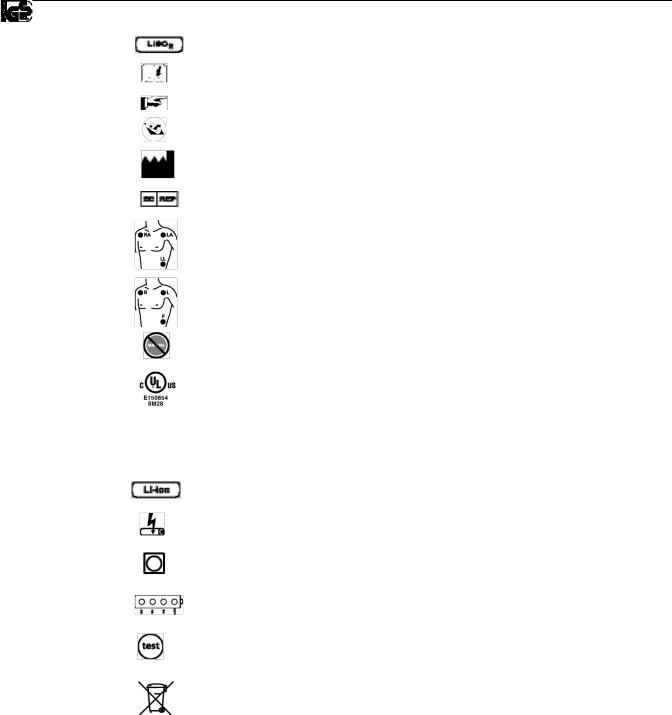
Section 1 - Safety
Lithium sulfur dioxide
Additional information is provided in the AED Operation and Service Manual. Points to important information regarding the use of the AED.
Lift here
Manufacturer
Authorized European Representative
Indicates placement of ECG leads and electrodes, AHA.
Indicates placement of ECG leads and electrodes, IEC.
Indicates that the Manual Override function has been disabled.
C-UL US Classification Mark: indicates compliance with US and Canadian safety requirements.
GS Mark: indicates compliance with German safety requirements.
Lithium Ion
Rechargeable Battery
Charge LED: Solid yellow indicates battery charging, blinking yellow indicates charging error.
Battery Capacity: Indicates the AED battery status. The illuminated areas indicate the remaining battery capacity when the test button is pressed.
Test Button: Push to view battery capacity
Symbol for the marking of electrical and electronic equipment that must be recycled.
© 2006 Cardiac Science Corp. All rights reserved. |
112-2034-301 Rev A |
page 13 |

page 14 |
112-2034-301 Rev B |
© 2006 Cardiac Science Corp. All rights reserved. |

Section 2 - Introduction
SECTION 2 – INTRODUCTION
OVERVIEW
This section presents information about the AED, its use, and the training requirements for operation.
Topic |
Page # |
AED Description |
15 |
Indications for Use |
15 |
RHYTHMx AED ECG Analysis Algorithm |
16 |
Rescue Protocol |
18 |
STAR Biphasic Waveform |
18 |
STAR Biphasic Energy Protocols for Powerheart AED |
18 |
Operator Training Requirements |
20 |
AED DESCRIPTION
The AED is a self-testing, battery-operated automated external defibrillator (AED). After applying the AED’s defibrillation pads to the patient’s chest, the AED automatically analyzes the patient’s electrocardiogram (ECG) and advises the operator to push the button and deliver a shock if needed. The AED guides the operator through the rescue using a combination of voice prompts, audible alerts, and visible indicators. At the discretion of Advanced Life Support (ALS) personnel, the AED can be converted to manual override mode, and deliver a shock by pushing the SHOCK button. The AED can also provide non-diagnostic ECG monitoring.
INDICATIONS FOR USE
The AED with STAR Biphasic Waveform is intended to be used by personnel who have been trained in its operation. The operator should be qualified by training in basic life support, CPR/AED or other physician-authorized emergency medical response. The device is indicated for emergency treatment of victims exhibiting symptoms of sudden cardiac arrest who are unresponsive and not breathing. If the victim is breathing post-resuscitation, the AED should be left attached to allow for acquisition and detection of the ECG rhythm. If a shockable ventricular tachyarrhythmia recurs, the device will charge automatically and advise the operator to deliver therapy; or when in manual override mode, ALS personnel will monitor the ECG display and deliver a shock by pushing the shock button to deliver therapy.
When the patient is a child under 8 years of age or weighs less than 55 lbs (25kg), the AED should be used with the Model 9730 Pediatric Attenuated Defibrillation Electrodes. Therapy should not be delayed to determine the patient’s exact age or weight.
© 2006 Cardiac Science Corp. All rights reserved. |
112-2034-301 Rev A |
page 15 |

RHYTHMx® AED ECG ANALYSIS ALGORITHM
The RHYTHMx AED ECG analysis algorithm provides ECG detection capabilities, The features available with the AED include the following:
•Detection Rate
•Asystole Threshold
•Noise Detection
•Non-Committed Shock
•Synchronized Shock
•Pacemaker Pulse Rejection
•SVT Discriminators
•Supraventricular Tachycardia (SVT) Rate
DETECTION RATE
All ventricular fibrillation (VF) and ventricular tachycardia (VT) rhythms at or above this rate will be classified as shockable. All rhythms below this rate will be classified as non-shockable. This rate is programmable between 120 bpm (beats per minute) and 240 bpm via MDLink Software by the Medical Director. The default Detection Rate is 160 bpm.
ASYSTOLE THRESHOLD
The asystole baseline-to-peak threshold is set at 0.08 mV. ECG rhythms at or below 0.08 mV will be classified as asystole and will not be shockable.
NOISE DETECTION
The AED will detect noise artifact in the ECG. Noise could be introduced by excessive moving of the patient or electronic noise from external sources like cellular and radiotelephones. When noise is detected, the AED will issue the prompt “ANALYSIS INTERRUPTED. STOP PATIENT MOTION” to warn the operator. The AED will then proceed to reanalyze the rhythm and continue with the rescue.
NON-COMMITTED SHOCK
After the AED advises a shock, it continues to monitor the patient ECG rhythm. If the patient’s rhythm changes to a non-shockable rhythm before the actual shock is delivered, the AED will advise that the rhythm has changed and issue the prompt “RHYTHM CHANGED. SHOCK CANCELLED.” The AED will enter the CPR mode and prompt, "START CPR".
page 16 |
112-2034-301 Rev B |
© 2006 Cardiac Science Corp. All rights reserved. |

Section 2 - Introduction
SYNCHRONIZED SHOCK
The AED is designed to synchronize shock delivery on the R-wave. The AED will automatically attempt to synchronize to the R-wave. If delivery cannot be synchronized within one second, a non-synchronized shock will be delivered.
PACEMAKER PULSE DETECTION
The AED contains pacemaker pulse detection circuitry to detect pulses from an implanted pacemaker.
SVT DISCRIMINATORS
The AED is supplied with the SVT Discriminator enabled and with the default setting “NO THERAPY FOR SVT”. With the factory default setting of “NO THERAPY FOR SVT”, the AED will not shock an SVT rhythm.
SVT Discriminators are sophisticated filters that analyze the morphology of the ECG waveforms and distinguish VF/VT from SVT and Normal Sinus Rhythms (NSR). The SVT Discriminator will only be applied to rhythms that fall between the Detection Rate and the SVT Rate. The factory default setting for this feature is
“NO THERAPY FOR SVT”, however the Medical Director can enable this feature using MDLink on the AED.
SVT RATE
All rhythms with rates between the Detection Rate and SVT Rate will be screened through a number of SVT Discriminators to classify them into VF/VT or SVT. Rhythms classified as SVT between the two set rates are not shockable. All SVT rhythms above the rates will be classified as shockable. The SVT Rate must be greater than the Detection Rate and is selectable between 160 and 300 bpm or, “NO THERAPY FOR SVT” can be selected via MDLink Software by the Medical Director on the AED.
© 2006 Cardiac Science Corp. All rights reserved. |
112-2034-301 Rev A |
page 17 |
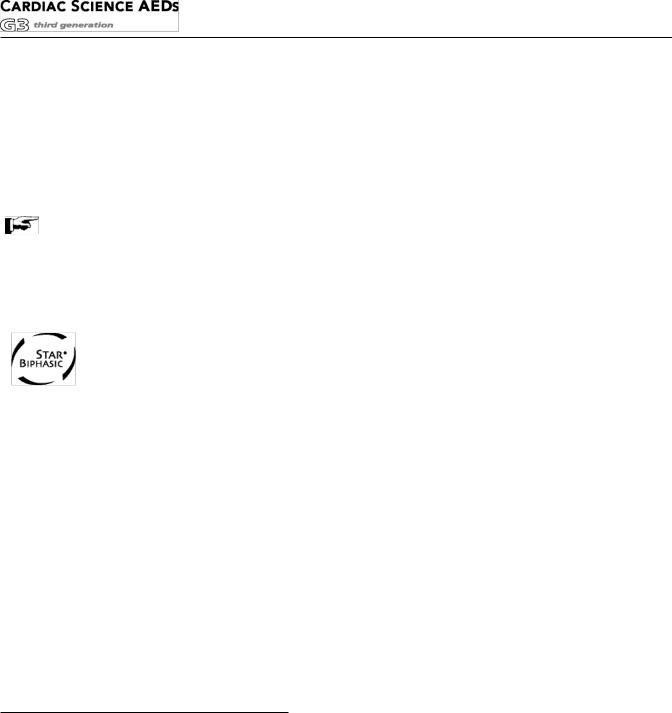
RESCUE PROTOCOL
The AED rescue protocol is consistent with the guidelines recommended by the American Heart Association (AHA)1 and the International Liaison Committee on Resuscitation (ILCOR).
Upon detecting a shockable cardiac rhythm, the AED advises the operator to press the SHOCK button to deliver a shock and then advises the operator to start CPR.
Note: The standard CPR protocol of 120 seconds can be modified from 60 to 180 seconds in MDLink.
STAR BIPHASIC WAVEFORM
The STAR Biphasic Waveform is designed to measure the patient’s impedance and deliver a customized shock. This allows the delivery of an optimized energy level to each patient. The energy levels for the AED are available in three different defibrillation shock2 configurations. See table on next page and page 59 for additional information.
STAR BIPHASIC ENERGY PROTOCOLS FOR POWERHEART AED G3 PRO
Cardiac Science’s patented STAR® Biphasic defibrillation waveform will deliver variable escalating energy that is customized to each patient’s needs based upon a patient’s thoracic impedance. This customization adjusts for the unique physical differences between patients. The range of impedance over which the device will deliver a shock is 25-180 Ohms. The AED comes equipped with five different FDA cleared biphasic energy protocols.
The operator, with guidance, direction and implementation from its designated AED program Medical Director, may select from one of these five protocols when placing the AED into service. The AED’s factory default energy protocol is 200-300-300 Joule (J) escalating Variable Energy (VE). The first shock is delivered within the range of 140J-250J (200J nominal). Subsequent shocks are delivered within a range of 190J-360J (300J nominal). See next page.
1“Guidelines 2005 for Cardiopulmonary Resuscitation and Emergency Cardiovascular Care” American Heart Association; Circulation Vol 112,Issue 24 Suppl. Dec 13, 2005
2The ultra-low current, low current and high current shocks are variable energy. The actual energy is determined by the patient’s impedance.
page 18 |
112-2034-301 Rev B |
© 2006 Cardiac Science Corp. All rights reserved. |

Section 2 - Introduction
These protocols are selected by using our MDLink software program. The five biphasic energy protocols available are as follows:
|
Energy |
Shock |
Energy |
|
|
Protocols |
Sequence1 |
Level |
Energy Range (J) |
|
Factory Default |
1. |
200VE |
140J-250J |
|
|
2. |
300VE |
190J-360J |
|
|
3. |
300VE |
190J-360J |
|
Protocol #2 |
1. |
200VE |
140J-250J |
|
|
2. |
200VE |
140J-250J |
|
|
3. |
300VE |
190J-360J |
|
Protocol #3 |
1. |
150VE |
105J-195J |
|
|
2. |
200VE |
140J-250J |
|
|
3. |
200VE |
140J-250J |
|
Protocol #4 |
1. |
150VE |
105J-195J |
|
|
2. |
150VE |
105J-195J |
|
|
3. |
200VE |
140J-250J |
|
Protocol #5 |
1. |
200VE |
140J-250J |
|
|
2. |
200VE |
140J-250J |
|
|
3. |
200VE |
140J-250J |
|
|
|
|
|
1 The ultra-low current, low current and high current shocks are variable energy. The actual energy is determined by the patient’s impedance.
© 2006 Cardiac Science Corp. All rights reserved. 112-2034-301 Rev A page 19
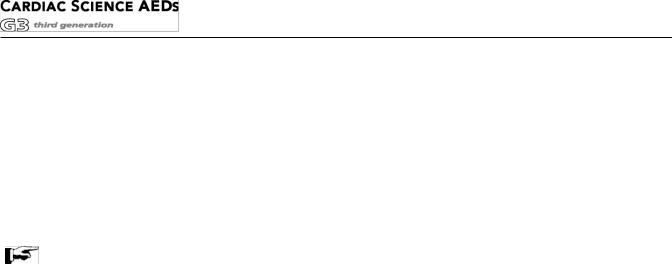
OPERATOR TRAINING REQUIREMENTS
Persons authorized to operate the AED must have all of the following minimum training:
•Defibrillation training and other training as required by state, province, or country regulations.
•Training on operation and use of the AED.
•Additional training as required by the physician or Medical Director.
•A thorough understanding of the procedures in this manual.
Notes: Keep valid certificates of training and certification as required by state, province, or country regulations.
page 20 |
112-2034-301 Rev B |
© 2006 Cardiac Science Corp. All rights reserved. |

Section 3 - Getting Started
SECTION 3 – GETTING STARTED
OVERVIEW
This section presents information on unpacking and setting up the AED
Topic |
Page # |
Unpacking and Inspecting |
21 |
AED Parts |
22 |
AED Modes |
23 |
Powerheart AED G3 Pro Batteries |
24 |
Rechargeable Battery and Charger |
26 |
Defibrillation Pads (Electrodes) |
28 |
AED Indicators |
29 |
Setting the AED Internal Clock |
33 |
Voice Prompts and Text Display |
33 |
UNPACKING AND INSPECTING
Every attempt is made to ensure your order is accurate and complete. However, to be sure that your order is correct, verify the contents of the box against your packing slip.
If you have any questions about your order, contact Customer Service. See page 4.
© 2006 Cardiac Science Corp. All rights reserved. |
112-2034-301 Rev A |
page 21 |
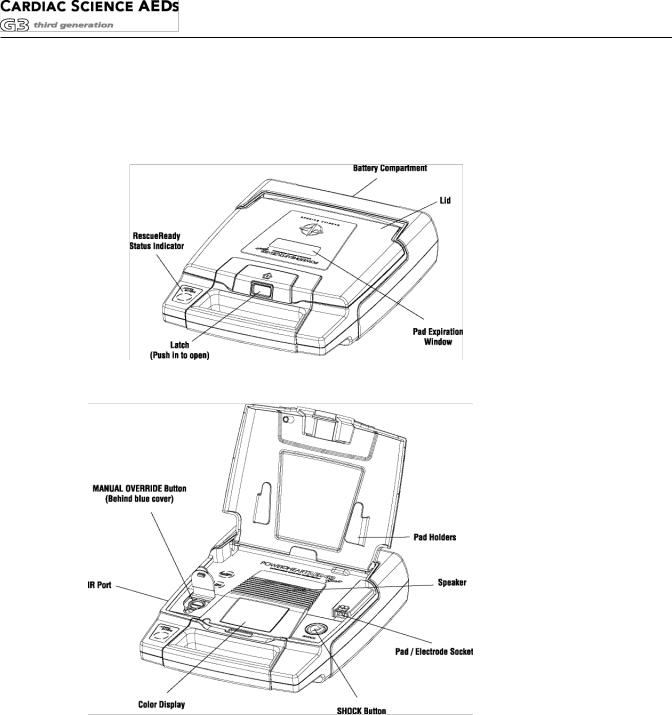
AED PARTS
The following drawings show the AED parts and their locations.
page 22 |
112-2034-301 Rev B |
© 2006 Cardiac Science Corp. All rights reserved. |

Section 3 - Getting Started
AED MODES
Operating Mode: When the battery is installed and the lid is open. This is the mode the AED would be in during an actual rescue situation.
Standby Mode: When the battery is installed, but the lid is closed. This is the mode the AED is normally in when not being used in a rescue. The device will conduct its routine self-tests to ensure proper operation.
Storage Mode: When the battery is removed, such as during shipping or transport. With the battery removed, the AED is unable to perform self-tests or rescues.
ENVIRONMENTAL OPERATING AND STANDBY CONDITIONS
See Section 7 – Technical Data, Parameters, Environmental Operation and Standby Conditions.
CAUTION: Temperature Extremes
Exposing the AED to extreme environmental conditions outside of its operating parameters may compromise the ability of the AED to function properly. The RescueReady® daily self-test verifies the impact of extreme environmental conditions on the AED; if the daily self-test determines environmental conditions outside of the AED’s operating parameters, a “SERVICE REQUIRED” alert will be issued to prompt the user to move the AED to environmental conditions within the acceptable operating parameters at once. See Section 7 – Technical Data, Parameters, Operation and Standby Conditions.
SHIPPING AND TRANSPORT CONDITIONS
(For up to 1 week)
See Section 7 – Technical Data, Safety and Performance Standards/Shipping and Transportation Conditions.
© 2006 Cardiac Science Corp. All rights reserved. |
112-2034-301 Rev A |
page 23 |
